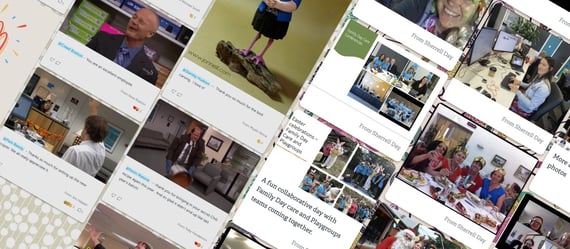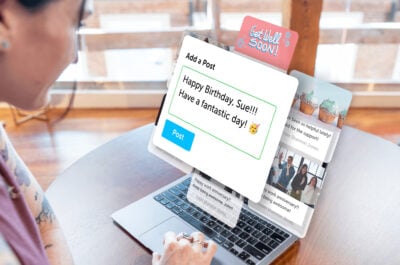In the changing landscape of work, employee recognition is crucial for maintaining employee happiness and productivity. These efforts focus on praising employees for productivity and achievement, incorporating appreciation for contributions and soft skills, and celebrating employee milestones. A company can recognize its employees in many ways, and knowing what strategies to implement might be overwhelming.
As you seek employee recognition ideas to incorporate into your employee recognition program, a good place to start is with employee recognition boards. These boards serve as a visual testament to employees’ achievements and hard work, creating a sense of appreciation and camaraderie within the organization. They can address many styles of appreciation, are easily adapted, and, most importantly, effectively boost a workplace culture.
This article will discuss employee recognition boards and their benefits and give you 12 ideas to help inspire you as you seek to create your own.
What is an Employee Recognition Board?
An employee recognition board is a dedicated space within the workplace where employees’ accomplishments, milestones, and contributions are acknowledged and celebrated. It goes beyond conventional recognition methods, providing a tangible and public platform for expressing gratitude and admiration.
Employee appreciation boards can feature photos, videos, personal anecdotes, positive customer reviews, and more. These boards can come in all shapes and sizes, making them easily adapted to fit the unique way your organization wishes to celebrate one another’s accomplishments.
What are the Benefits of Employee Recognition Boards?
In a busy workplace environment where there is always something more to do, it might seem wasteful to dedicate precious time to creating and maintaining an employee appreciation board. While they do take a small amount of time, particularly at first, employee recognition boards yield many benefits for the employees and the organization as a whole. Some of these benefits include:
Improved morale and motivation
Acknowledging employees’ achievements boosts morale and motivation by demonstrating that the unique things they bring or do are seen and valued. As they begin to know that their hard work is seen, they will find greater motivation to continue to work at that level or higher. Additionally, praise among colleagues fosters a positive work environment, which maintains morale.
Enhanced employee engagement
Recognition boards create a sense of belonging and engagement. When employees feel valued by their peers, they are more likely to be actively involved in their work and contribute to the organization’s success.
Strengthen team dynamics
Recognition boards promote a sense of unity and camaraderie among team members. Celebrating individual and collective achievements strengthens the bonds within the team, fostering a collaborative and supportive culture. As they build connections, teams can work more efficiently and productively.
Improve retention rates
Recognizing employees for their contributions and milestones can contribute to higher employee satisfaction and, consequently, improved retention rates. Employees are likelier to stay with an organization that values and appreciates their efforts. Additionally, praise helps foster a connection to an organization and its people, which will keep employees invested.
Improves communication
Employee recognition walls allow different departments to see how each team contributes to the company’s larger vision. As the board celebrates success, it can bridge various communication gaps that might exist among departments.
Attract top talent
A workplace with a strong culture of recognition becomes an attractive prospect for potential hires. Word-of-mouth about a positive work environment can enhance the organization’s reputation, making it more appealing for top talent.
Align with organizational values
Recognition boards provide a tangible way to showcase and reinforce organizational values. Praise highlighting achievements that align with these values reminds employees of the principles that guide the company.
Read more: How to Use Employee Retention Models to Reduce Turnover

Types of Recognition Boards
Recognition boards come in various forms, catering to different organizational cultures and preferences. As you gauge the employee recognition needs of your company, you can get creative and produce a recognition board that will help your workplace culture thrive.
To inspire your venture to implement a board, here are some common types of employee recognition boards for you to adopt and adapt:
Traditional Recognition Bulletin Board
The classic choice, a bulletin board allows for easy customization and display of achievements. It serves as a central hub for recognizing individual and team accomplishments displaying certificates, thank-you notes, and photos.
Digital Display Screens
In the age of technology, digital screens offer a modern twist to recognition boards. If your office utilizes various display screens around the workplace, an employee recognition board can be yet another use for them. These screens can showcase a rotating display of employee achievements, along with real-time updates and announcements. This location can also be a great way to show off your employees to the customers.
Interactive Online Platforms
Virtual employee recognition software, like that of Kudoboard, is a digital space for boards where employees can post their achievement, celebrate occasions, and recognize their peers. This builds community and allows for a broader reach, especially in organizations with remote or geographically dispersed teams.
Themed Boards
Tailoring recognition boards to specific themes or occasions adds a creative touch. Whether it’s a seasonal board, a project-specific board, or one dedicated to highlighting unique skills or company values, themed boards make recognition more personalized and engaging.
Staff Shout-Outs
A staff shout-out board is a centralized place where colleagues can quickly write notes praising their peers. These boards can be displayed physically, like on a wall in the office, or virtually through an online shout-out board.
12 Employee Recognition Board Ideas
If you’re ready to create your board, the good news is that it can take any direction you wish. The bad news is that you might need help knowing where to begin with so many options. So, to inspire you, here are 12 creative ideas that can be used in any workspace, no matter if your workplace is physical, remote, or a little bit of both:
1. Spotlight of the Month
Spotlight an outstanding employee each month. Include their photo, a brief bio, and a list of their accomplishments. A spotlight recognizes individual efforts and allows employees to get to know their colleagues better.
2. Innovation Wall
Showcase groundbreaking ideas and innovations that have positively impacted the organization. Pointing out innovation encourages a culture of creativity and problem-solving while recognizing employees’ contributions to the company’s success.
3. Milestone Marathon
Create a visual representation of employees’ service milestones. Use a timeline format to showcase each employee’s duration with the company. This acknowledges their commitment and instills a sense of pride in their long-term association with the organization.
4. Shout-Out Board

Designate a space for shout-outs and praise among coworkers with a shout-out board. Employees can write notes of appreciation for their colleagues and pin them on the board. It fosters a culture of gratitude and encourages positive interactions among team members as colleagues look for ways to praise one another. An appreciation corner can be easily adapted to remote teams’ online employee appreciation platform.
5. Customer Champions
Utilize your employee appreciation board to highlight exceptional customer feedback and testimonials. Doing so will recognize the efforts of individual employees in customer service and reinforce the connection between their work and its impact on customers. Receiving and highlighting positive customer feedback can be a very valuable experience for your employees.
6. Learning Wall
Acknowledge employees who have invested time in professional development. Include certifications, completed courses, and workshops attended. Spotlighting continuing education will reinforce this value, recognize those putting in the effort to grow and learn new industry skills, and also help inspire others to pursue continuous learning.
7. Fitness and Wellness Corner
If your workplace values a well-rounded and healthy employee, a fitness and wellness corner can be a great way to promote a healthy workplace. Create an employee recognition board that recognizes employees participating in company fitness challenges and wellness programs or making healthy lifestyle choices.
You can also use this space to feature those employees who are accomplishing their personal wellness and fitness goals, like completing a marathon, adopting a fitness routine, or developing a mindfulness routine.
8. Sustainability Champions Board
Recognize employees who contribute to sustainability initiatives within the organization. A board like this could involve implementing eco-friendly practices, reducing waste, or spearheading green initiatives. It acknowledges their efforts and promotes a culture of environmental responsibility. Human resources can easily roll these boards out as a part of a larger spring employee appreciation program.
9. Team Collaboration Wall:

Celebrate successful team collaborations and projects, showcase team achievements, project milestones, and collaborative efforts that have significantly impacted the organization’s success. A team collaboration wall/board can be the perfect space to display how your teams work towards solutions through successful teamwork, conflict management, and caring for one another.
10. Random Acts of Kindness Board
Create a space to acknowledge and appreciate small acts of kindness among team members. Whether helping a colleague with a project, offering support during a busy period, or simply spreading positivity, recognizing these gestures fosters a positive and supportive work culture. This type of recognition board can be a more inclusive way to appreciate team members publicly. It is not based on achievement but rather on being a kind coworker, which anyone can do.
11. Success Story Showcase
One employee recognition idea is to create a board dedicated to showcasing success stories within the organization. This type of board highlights individual employees’ or teams’ journeys and accomplishments in overcoming challenges or achieving exceptional results.
This type of board can include before-and-after visuals, like visual representations or timelines that showcase the progression of a project or an individual’s growth within the company. It also can display quotes and anecdotes from employees sharing their experiences, lessons learned, and the strategies they employed to achieve success, as well as collaborative contributions showcasing the diverse skills and contributions that led to success.
12. Personal Achievements
While employees spend most of their day working toward your organization’s success, they also have a valuable personal life. An employee recognition board can be a great way to demonstrate you appreciate and value the person they are professionally and personally. A board like this can spotlight personal goals achieved, like a home renovation, learning a new language, and finally traveling to their dream location. It can also highlight personal milestones like graduations, weddings, birthdays, wedding anniversaries, the birth of a child, and more.
How Can I Make an Employee Recognition Board?
Because every board and every organization will be different, the steps for creating a board will vary. However, there are some basic steps that you can use to help guide you through the process. Here is a step-by-step guide to assist you in bringing your recognition board to life:
Define the Purpose
Clearly outline the objectives of your recognition board. Whether it’s to boost employee morale, celebrate milestones, or promote a specific value, having a clear purpose will guide the design and content of the board.
Choose the Type and Location
Based on your decided purpose, select a theme that best aligns with the type of recognition that meets those goals. Choose the format that best suits your workplace, whether it’s a traditional bulletin board, a digital display, or a virtual recognition board. Once you’ve decided upon the type, select a high-traffic location or the best online platform to use for the board.
Design the Board
Consider the visual appeal of your recognition board. Use a clean and organized layout that is easy to navigate. Incorporate the company’s branding elements to give the board a professional and cohesive look. However, don’t be afraid to make the board feel personal by adding things that make it feel personal and relatable. Include photos of employees, personal quotes, or anecdotes highlighting their personalities and contributions. This will make the recognition more meaningful.
Establish Recognition Criteria
Clearly define the criteria for recognition to ensure fairness and consistency. Whether based on individual achievements, teamwork, or adherence to organizational values, having transparent criteria sets the standard for acknowledgment.
Regular Updates
Keep the content on the recognition board fresh and up-to-date. Regularly update it with new achievements, milestones, and announcements. This ensures that employees remain engaged and excited about the board.
Seek Feedback
Actively seek feedback from employees on the recognition board. Understand what resonates with them and how you can improve it. This continuous feedback loop ensures that the recognition board remains a relevant and impactful tool.
As you create an employee recognition board with careful planning and consideration, you can establish a board tailored to your organization’s needs and most beneficial to your employees.
How Do I Ensure My Board is Successful?
Implementing an Employee Recognition Board is just the beginning; ensuring its success requires ongoing effort and commitment. For your board to succeed, there must be continual communication on why it is crucial and a president set. You can most effectively do this through the example and guidance of your leaders.
Team leaders should spearhead any employee recognition board efforts. While that might seem like a lot of responsibility, at its core, it means they need to be the ones participating in recognition efforts. Praise and positivity are contagious, so their efforts to write appreciation can inspire team members to do the same.
In addition to your leaders seeking to set the example and expectations, there are further strategies to make your recognition board a thriving and integral part of your workplace culture.
Best Practices of Employee Appreciation Boards
For an employee recognition board to be successful, you must actively avoid some of the pitfalls that might occur by creating one. Some problems that might arise as you implement recognition boards are continual maintenance, favoritism or bias, and inequality in praise. You must implement practices that actively work against these issues.
To produce the best results and avoid any disadvantages, here are some best practices when implementing an employee recognition board:
Celebrate diverse achievements
Ensure that the recognition board reflects the diversity of achievements within the organization. Celebrate both significant milestones and small victories to create a comprehensive and inclusive representation of success.
Promote inclusivity
Ensure the recognition board is inclusive and represents all organizational departments and levels. No achievement is too small to be celebrated, and a diverse representation fosters a sense of unity among employees.
Align with company values
Regularly review the content on the recognition board to ensure alignment with the company’s values and goals. This guarantees that the board reflects the organization’s principles and reinforces the desired behaviors.
Integrate with current recognition program
Integrate the recognition board with an existing employee recognition program. This creates a cohesive approach to acknowledging and rewarding employees, reinforcing a culture of appreciation.
Recognize both individual and team achievements
Strike a balance between recognizing individual accomplishments and celebrating team achievements. This promotes a collaborative spirit and acknowledges the collective efforts contributing to the organization’s success.
Regular communication
Communicate the purpose and significance of the recognition board regularly. Use internal communication channels to highlight featured achievements, share success stories, and remind employees of the impact of their contributions. If creating a digital board, rely on integrations to increase visibility internally.
Don’t be afraid to change
Stay adaptable and open to evolving the recognition board based on feedback and changing organizational dynamics. A recognition board that evolves with the organization remains relevant and resonates with employees. So, don’t be afraid to modify the style and theme to address all types of recognition.
Employee Recognition Boards Create a Thriving Workplace
Employee recognition boards are a powerful tool for creating a positive and motivating workplace culture. By acknowledging and celebrating employees’ efforts, organizations can boost morale, enhance engagement, and foster a sense of community.
Whether through traditional bulletin boards, digital displays, or an interactive online recognition platform like Kudoboard, the key is to create a recognition board that aligns with the organization’s values and resonates with its employees.
With thoughtful planning, ongoing commitment, and a focus on inclusivity, your employee recognition board can become a cornerstone of a thriving and successful workplace.
Powerful employee recognition boards
Automate creation, enable easy access, and improve employee experience with Kudoboard.




